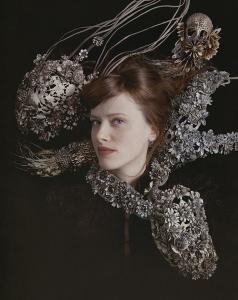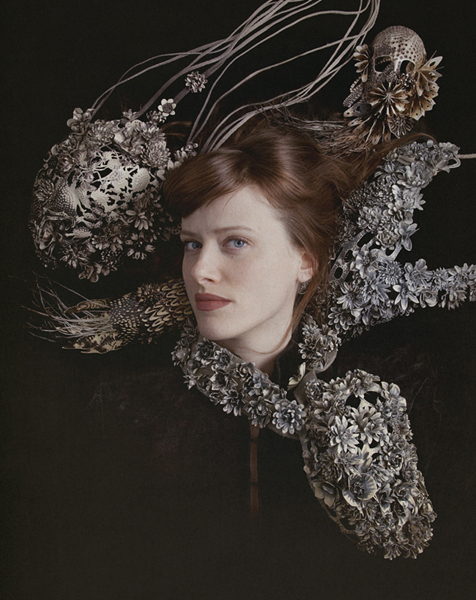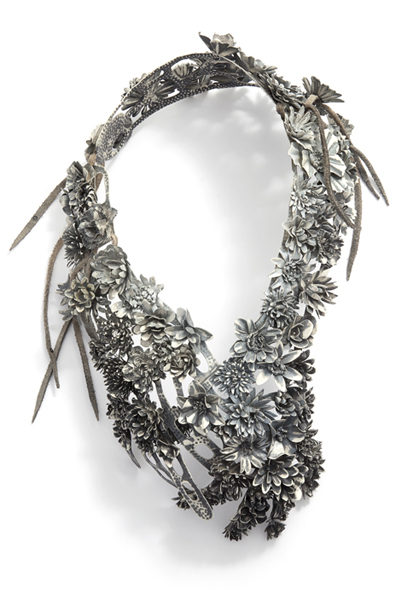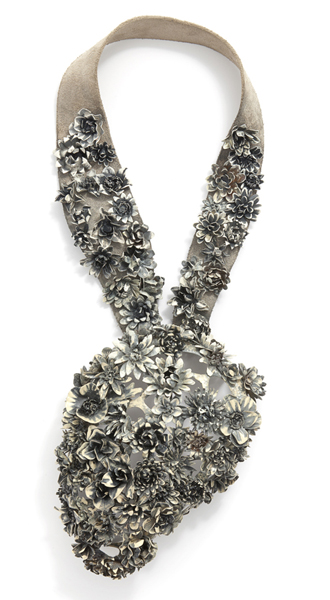
Susan Cummins: Can you tell me about your background and how you decided to become a jeweler?
Hanna Hedman: I have always been creative. As a young child, I loved making objects and drawings. My family always encouraged my creativity, even though they were not artists themselves. I started to dabble in jewelry by breaking my mother’s necklaces and reassembling them into what I believed were better versions. I was also a professional skier at a very young age, and skiing was a major part of my life for a long time. But, I always felt the need to express myself more with my hands. I made my first piece of jewelry while attending the University of Colorado on a skiing scholarship from 1999 to 2001. My work wasn’t very artistic at the start. I was drawn to the many possibilities of shaping metal. This is something that still intrigues me very much. My art life eventually superseded my sports life, and I haven’t stopped making since then. I work with jewelry for many reasons, but one is to explore jewelry’s direct relationship with the body.

Susan Cummins: Can you tell me about your background and how you decided to become a jeweler?
Hanna Hedman: I have always been creative. As a young child, I loved making objects and drawings. My family always encouraged my creativity, even though they were not artists themselves. I started to dabble in jewelry by breaking my mother’s necklaces and reassembling them into what I believed were better versions. I was also a professional skier at a very young age, and skiing was a major part of my life for a long time. But, I always felt the need to express myself more with my hands. I made my first piece of jewelry while attending the University of Colorado on a skiing scholarship from 1999 to 2001. My work wasn’t very artistic at the start. I was drawn to the many possibilities of shaping metal. This is something that still intrigues me very much. My art life eventually superseded my sports life, and I haven’t stopped making since then. I work with jewelry for many reasons, but one is to explore jewelry’s direct relationship with the body.

Hanna Hedman: It’s difficult to point to one person, because so many people have been important to me both professionally and personally. I am very thankful to have had Al Carniff as my first metal teacher. He never talked about right or wrong but instead let me learn on my own by making. He gave me a good foundation. Fredrik Ingemansson, who is a technical teacher at Konstfack in Stockholm, influenced me in the use of traditional techniques. As for an artistic influence, I would have to name Ruudt Peters, who was my professor for two years at Konstfack. He pushed me hard, made me braver, and helped me recognize what was important to me.
This new work is very different from things I have seen before. Can you tell us something about how your designs have evolved?
Hanna Hedman: The real story about how the work developed is too personal to tell, but I have taken inspiration from the talismanic objects and memento mori jewelry I have seen in books and museums. I want my jewelry to be timeless and difficult to associate with a certain time period.
Are you using the same basic techniques as in the past?
Hanna Hedman: I am still trying to push the metal in making three-dimensional objects out of flat sheets. The objects still develop organically during the making, without much preplanning of the finished results. I haven’t done any soldering, but I am still obsessively drilling, cutting, and shaping as before. But for this series, I’ve used the techniques of chasing and repoussé. I have also started to work with leather as a complement to the metal.

Hanna Hedman: It is related to the notion that beauty dies when it reaches perfection. The idea is a romantic one, but it can also be frightening, like the feeling of emptiness one gets sometimes when seeing something very beautiful. As a nod to traditional vanitas still life paintings, for example, I have used conventional symbols, such as flowers and skulls, to convey beauty and death.
The title of the show, Black Bile, conjures up ugly, smelly, and disgusting images. It’s unusual for a jewelry show. How did you decide to use it?
Hanna Hedman: It’s a reference to the Greek word for melancholy, which is translated as “black bile.” It also refers to a feeling I had while making the work. Because of the long Swedish winters and, more likely, the fact that Sweden is such a safe and quiet place to live, my own work often deviates toward sadness and has an aspect of darkness. I like to transfer the viewer, wearer, and myself into a melancholic mood. At first you see beauty, but then, as you look more closely, you perceive not only a shallow surface but also something else that is frightening and unusual.

Hanna Hedman: I think Scandinavia was already on the jewelry map before the exhibition From the Coolest Corner. Over the past 10 years, the Internet has made information and images more accessible, and as a result, brought countries and cultures closer together. I don’t believe that all characteristics of the work from this region are typically Scandinavian. Countries within Scandinavia have different traditions. Denmark, for example, has always been known for its goldsmithing. Sweden, on the other hand, has a long tradition of silversmithing. The different art institutions and professors at the universities also influence students’ work. And although Stockholm and Gothenburg are both Swedish cities, the work from each location is very distinct. Non-Scandinavians often characterize my work as Scandinavian, but I think my time in New Zealand and my interest in the British Victorian era and its aesthetic have influenced my designs greatly.
What is currently your favorite jewelry book?
Hanna Hedman: For this project, I was very inspired by Pacific Jewelry and Adornment by Roger Neich and Fuli Pereira. I received this book as a gift many years ago. It contains many beautiful forms and connections. I was also deeply inspired by a non-jewelry book recommended to me by jeweler and gallerist Fabrice Schaefer. Wilder Mann: The Image of the Savage, by Charles Fréger, examines the tradition of the mask in Europe. It is filled with inspirational mystical and naturalistic costumes. I recommend this book to everyone.





